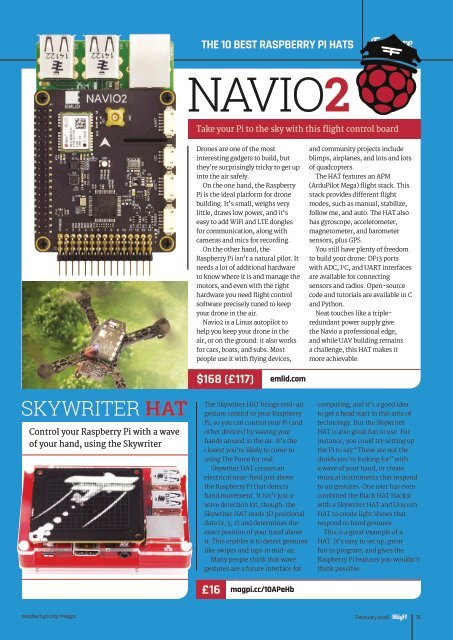Create successful ePaper yourself
Turn your PDF publications into a flip-book with our unique Google optimized e-Paper software.
THE 10 BEST RASPBERRY <strong>PI</strong> HATS<br />
Feature<br />
NAVIO2<br />
Take your Pi to the sky with this flight control board<br />
Drones are one of the most<br />
interesting gadgets to build, but<br />
they’re surprisingly tricky to get up<br />
into the air safely.<br />
On the one hand, the Raspberry<br />
Pi is the ideal platform for drone<br />
building. It’s small, weighs very<br />
little, draws low power, and it’s<br />
easy to add WiFi and LTE dongles<br />
for communication, along with<br />
cameras and mics for recording.<br />
On the other hand, the<br />
Raspberry Pi isn’t a natural pilot. It<br />
needs a lot of additional hardware<br />
to know where it is and manage the<br />
motors, and even with the right<br />
hardware you need flight control<br />
software precisely tuned to keep<br />
your drone in the air.<br />
Navio2 is a Linux autopilot to<br />
help you keep your drone in the<br />
air, or on the ground: it also works<br />
for cars, boats, and subs. Most<br />
people use it with flying devices,<br />
and community projects include<br />
blimps, airplanes, and lots and lots<br />
of quadcopters.<br />
The HAT features an APM<br />
(ArduPilot Mega) flight stack. This<br />
stack provides different flight<br />
modes, such as manual, stabilize,<br />
follow me, and auto. The HAT also<br />
has gyroscope, accelerometer,<br />
magnetometer, and barometer<br />
sensors, plus GPS.<br />
You still have plenty of freedom<br />
to build your drone: DF13 ports<br />
with ADC, I 2 C, and UART interfaces<br />
are available for connecting<br />
sensors and radios. Open-source<br />
code and tutorials are available in C<br />
and Python.<br />
Neat touches like a tripleredundant<br />
power supply give<br />
the Navio a professional edge,<br />
and while UAV building remains<br />
a challenge, this HAT makes it<br />
more achievable.<br />
$168 (£117)<br />
emlid.com<br />
SKYWRITER HAT<br />
Control your Raspberry Pi with a wave<br />
of your hand, using the Skywriter<br />
The Skywriter HAT brings mid-air<br />
gesture control to your Raspberry<br />
Pi, so you can control your Pi (and<br />
other devices) by waving your<br />
hands around in the air. It’s the<br />
closest you’re likely to come to<br />
using The Force for real.<br />
Skywriter HAT creates an<br />
electrical near-field just above<br />
the Raspberry Pi that detects<br />
hand movement. It isn’t just a<br />
wave detection kit, though: the<br />
Skywriter HAT reads 3D positional<br />
data (x, y, z) and determines the<br />
exact position of your hand above<br />
it. This enables it to detect gestures<br />
like swipes and taps in mid-air.<br />
Many people think that wave<br />
gestures are a future interface for<br />
computing, and it’s a good idea<br />
to get a head start in this area of<br />
technology. But the Skywriter<br />
HAT is also great fun to use. For<br />
instance, you could try setting up<br />
the Pi to say “These are not the<br />
droids you’re looking for” with<br />
a wave of your hand, or create<br />
musical instruments that respond<br />
to air gestures. One user has even<br />
combined the Black HAT Hack3r<br />
with a Skywriter HAT and Unicorn<br />
HAT to create light shows that<br />
respond to hand gestures.<br />
This is a great example of a<br />
HAT. It’s easy to set up, great<br />
fun to program, and gives the<br />
Raspberry Pi features you wouldn’t<br />
think possible.<br />
£16<br />
magpi.cc/1OAPeHb<br />
raspberrypi.org/magpi February 2016<br />
75


